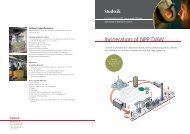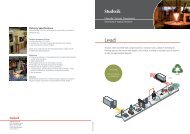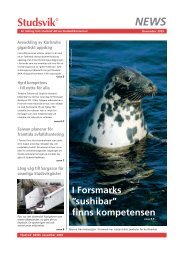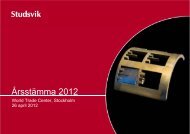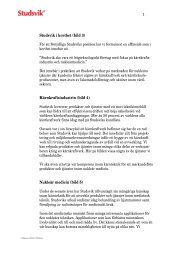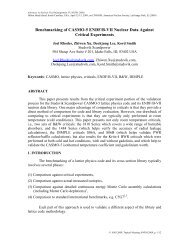Robust PCI Monitoring During PWR Operation at ... - Studsvik
Robust PCI Monitoring During PWR Operation at ... - Studsvik
Robust PCI Monitoring During PWR Operation at ... - Studsvik
- No tags were found...
You also want an ePaper? Increase the reach of your titles
YUMPU automatically turns print PDFs into web optimized ePapers that Google loves.
Proceedings of 2010 LWR Fuel Performance/TopFuel/WRFPMOrlando, Florida, USA, September 26-29, 2010Paper 097Fig. 7. Margin to <strong>PCI</strong> <strong>During</strong> Open Valve Test fromThreshold ModelAlthough every pin was evalu<strong>at</strong>ed for susceptibility to<strong>PCI</strong>, a simple way to summarize the event is shown in thefigure as <strong>PCI</strong>UTL (shown in blue). <strong>PCI</strong>UTL is defined asthe margin to <strong>PCI</strong> for the most limiting pin per time stepduring the event. The model accommod<strong>at</strong>es the situ<strong>at</strong>ionwhere the limiting pin loc<strong>at</strong>ion is changing from time stepto time step. Basically, the margin is calcul<strong>at</strong>ed for everypin and only the most limiting margin value is presented inthe figure. The results show th<strong>at</strong> there was sufficientmargin during the event to <strong>PCI</strong> failure.V. C. Thermo-Mechanical Fuel Performance AnalysisResultsThe last <strong>PCI</strong> analysis conducted for the open valve testwas to analyze every pin via the ONUS integr<strong>at</strong>ed fuelperformance analysis (ENIGMA and CMS using detailedoper<strong>at</strong>ional histories from CMSOps CMSOps) 10 .The most limiting parameter analyzed was the marginto maximum clad yield stress during the open valve test.The result is summarized here as Fig. 8. The ENGIMAanalysis assumed a failure yield stress of 93.5 kPSI. (Theactual limit is fuel design type- and exposure-dependent,but the vari<strong>at</strong>ion is insignificant with the amount of marginth<strong>at</strong> exists for the fuel during this test.)Fig. 8. Margin to Yield Stress Limit of Most Limiting Pin<strong>During</strong> Open Valve TestThe cases shown in the figure's x-axis correspond tothe time during which the open valve test was conducted,(approxim<strong>at</strong>ely 8 hours). In the figure, the most limitingpin – in terms of smallest margin to yield stress (cladfailure) – was in one of the assemblies which the leadcontrol bank was partially inserted/withdrawn. Theminimum margin occurred axially near the core mid-plane.The figure also shows the lead control bank positionduring the test and the LHGR of the limiting pin. Theminimum margin (highest stress) occurs <strong>at</strong> the deepestinsertion of the lead control bank, most probably due to theLHGR being redistributed as the lead control banksuppresses power in the upper axial region of theassemblies into which they are inserted.Other findings from the ONUS results are th<strong>at</strong> the pinswith the highest crack lengths (albeit with crack lengthsonly a fraction of 1% of the total clad thickness) are fromhigher depleted assemblies (pin-average exposures ofabout 45 GWd/T) where pellet clad gap closure will havealready occurred. However, because the higher depletedassemblies were loc<strong>at</strong>ed on the periphery of the core, thepin LHGRs before, during, and after the event wererel<strong>at</strong>ively low and consequently SCC propag<strong>at</strong>ionnegligible.Detailed pin-by-pin results for minimum margin yieldstress during the event are presented in Fig. 9. The axialloc<strong>at</strong>ion where the minimum margin occurs is in thebottom half of the core. When the lead control bank ispartially inserted, the power in this lower region of thecore increases leading to a system<strong>at</strong>ic increase in stress onthe clad (margin decrease). When this lead control bank isfully withdrawn, the power in this lower region decreasesagain and the stress on the clad relaxes (margin increase).





